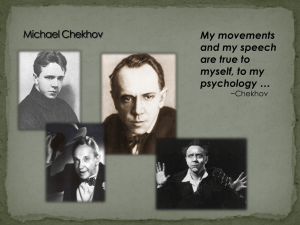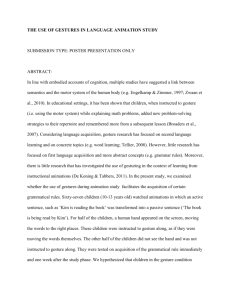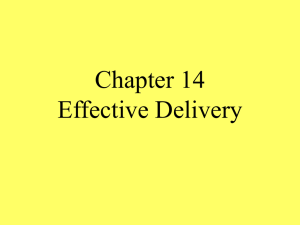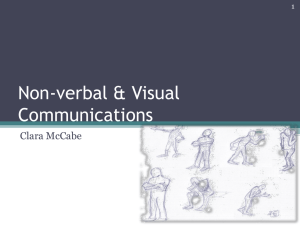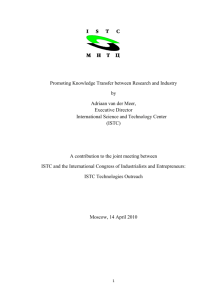Colloquium Speech and Gesture 5th September 2014
advertisement
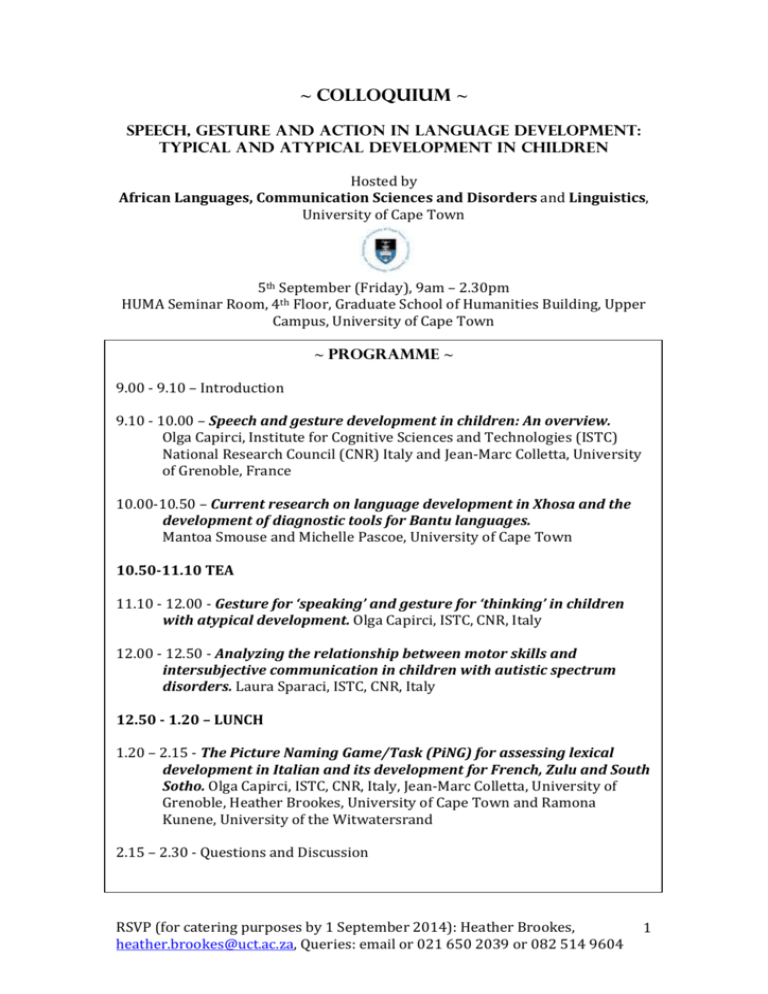
~ Colloquium ~ Speech, Gesture and Action in Language Development: Typical and atypical development in children Hosted by African Languages, Communication Sciences and Disorders and Linguistics, University of Cape Town 5th September (Friday), 9am – 2.30pm HUMA Seminar Room, 4th Floor, Graduate School of Humanities Building, Upper Campus, University of Cape Town ~ Programme ~ 9.00 - 9.10 – Introduction 9.10 - 10.00 – Speech and gesture development in children: An overview. Olga Capirci, Institute for Cognitive Sciences and Technologies (ISTC) National Research Council (CNR) Italy and Jean-Marc Colletta, University of Grenoble, France 10.00-10.50 – Current research on language development in Xhosa and the development of diagnostic tools for Bantu languages. Mantoa Smouse and Michelle Pascoe, University of Cape Town 10.50-11.10 TEA 11.10 - 12.00 - Gesture for ‘speaking’ and gesture for ‘thinking’ in children with atypical development. Olga Capirci, ISTC, CNR, Italy 12.00 - 12.50 - Analyzing the relationship between motor skills and intersubjective communication in children with autistic spectrum disorders. Laura Sparaci, ISTC, CNR, Italy 12.50 - 1.20 – LUNCH 1.20 – 2.15 - The Picture Naming Game/Task (PiNG) for assessing lexical development in Italian and its development for French, Zulu and South Sotho. Olga Capirci, ISTC, CNR, Italy, Jean-Marc Colletta, University of Grenoble, Heather Brookes, University of Cape Town and Ramona Kunene, University of the Witwatersrand 2.15 – 2.30 - Questions and Discussion RSVP (for catering purposes by 1 September 2014): Heather Brookes, heather.brookes@uct.ac.za, Queries: email or 021 650 2039 or 082 514 9604 1 ~ Purpose and Overview ~ The purpose of this colloquium is to share international and local research on typical and atypical speech and gesture development in children and introduce some new developments in language assessment for South African languages. This colloquium is part of a cross-disciplinary initiative to promote research on typical and atypical language development in African languages. This initiative, between the Faculties of Humanities and Health Sciences by African Languages, Communication Sciences and Disorders and Linguistics at the University of Cape Town, is linked to a four-year research project Gesture and Language Development across Romance and Bantu Languages funded by the Seventh Programme for Research and Technological Development Marie Curie IRSES, International Research Staff Exchange Scheme. This project is a joint collaboration led by Heather Brookes, University of Cape Town, Olga Capirci, National Research Council, Italy, Jean-Marc Colletta, University of Grenoble, France and Ramona Kunene, University of the Witwatersrand. It brings together expertise on multimodality in human interaction, language acquisition, gesture and cognition. The main goal is to share methods, data and multimodal annotation tools for the study of language and gesture, as well as to cooperate at a high scientific level. It also includes the training of young researchers and the enhancement of new professional practices in the field of speech therapy and related fields. On the scientific level, the programme tests the validity of a gesture task to assess early lexical abilities in children of different countries, explores the cognitive aspect of representational gesture in early and late childhood, and investigates the effect of linguistic and cultural constraints on multimodal language production in comparing two Romance and two Bantu languages. These are key issues in the field of language and gesture studies; a field that has developed rapidly within the last ten years and which is now at the cutting edge of the research on human communication and cognition. The exchange programme will extend the expertise of each one of the four research units involved. The outcome of the exchange is the introduction of a new language assessment tool for young children in South Africa and France, and the training of young researchers to do psycholinguistics and research on gesture and multimodality in human interaction, in South Africa as well as in Europe. 2 ~ Abstracts ~ Speech and gesture development in children: An overview. Olga Capirci, Institute for Cognitive Sciences and Technologies (ISTC) National Research Council (CNR) Italy and Jean-Marc Colletta, University of Grenoble, France Language is considered a gesture-speech integrated system. All children make use of gestures to communicate and there is a clear progression from prelinguistic to linguistic forms in actions, gestures and spoken words. However, the relationships between gestures and words vary in relation to developmental stages. How do children's gestures become organized into the adult speechgesture system? This talk will give an overview of what we know about the development of speech and gesture in both early and late acquisition. The development of diagnostic tools for Bantu languages and current research on language development in Xhosa. Michelle Pascoe and Mantoa Smouse, University of Cape Town In this talk we aim to give a brief overview of joint projects between the Departments of African Languages and Literatures, and Communication Sciences and Disorders. There is an acknowledged need for studies in Southern Africa that add to knowledge of children's acquisition of local languages. This is important for both theoretical and applied reasons. In this talk we will outline some smallscale studies that have detailed acquisition of phonology in the Bantu languages of IsiXhosa and Swahili. Clinical resources arising from this work will be introduced. The second part of the talk will focus on comprehension of isiXhosa and the work that has been carried out with children acquiring isiXhosa, and implications arising from these studies. Gesture for ‘speaking’ and gesture for ‘thinking’ in children with atypical development. Olga Capirci, ISTC, CNR, Italy There are now numerous descriptions of the relationship between gesture and the developing language system in typically-developing children; on the contrary, relatively little is known about this relationship in children with developmental disorders involving delayed language. Recent works on gestures and words in children with atypical development, underline that the motor representation (gesture) could constitute a ‘bridge’ in the construction and communication of meanings when the bond with the corresponding word appears to be weaker. When linguistic tasks and/or communication contexts are complex with respect to the linguistic competence of the speaker, gestures can activate and support the retrieval and the organization of the verbal expression, or substitute for it. The picture that emerges from these studies appears contradictory. Some studies have provided evidence of a greater reliance on gestures to compensate for difficulties in speech. Other studies have underlined the agreement of the use of the gestural modality and the level of cognitive and/or linguistic development. A complex but not contradictory picture emerges considering recent theories presented and discussed within this talk. The use of the gestural modality increases when there is disharmony between the level of cognitive-conceptual development (more preserved) and linguistic competence (more compromised). On the contrary, in those tasks or contexts of observation where cognitive and linguistic demands are not in conflict, gestural production is RSVP (for catering purposes by 1 September 2014): Heather Brookes, heather.brookes@uct.ac.za, Queries: email or 021 650 2039 or 082 514 9604 3 in accordance with the child’s level of development. Finally, it is important that clinicians and educators recognize that gestures can offer a guide in understanding conceptual representation in children and thus the information deriving from this channel should not be excluded from the evaluation process in these children. Analyzing the relationship between motor skills and intersubjective communication in children with autistic spectrum disorders. Laura Sparaci, ISTC, CNR, Italy Embodied approaches to intersubjective comprehension have highlighted how, before being able to theorize or simulate others’ mental states, we are already able to interact with, and to understand others in terms of expressions, intentions and emotions that rely on motor skills. This has often led to a more detailed analysis of motor skills in developmental disorders affecting intersubjective communication. In particular, during the last ten years, growing evidence of anomalous acquisition of motor skills has been a common, if not consistent, finding in children with autism spectrum disorders (ASD). Can differences in how these children learn motor procedures affect their communication skills and social interactions? In order to offer a viable answer, I will provide a brief overview of the most recent literature on learning of motor procedures in children with ASD and present the results of recent studies aimed at assessing differential strategies in implicit learning of a motor procedure and understanding other actions in children with ASD and in children with typical development. The Picture Naming Game/Task (PiNG) for assessing lexical development in Italian and its development for French, Zulu and South Sotho. Olga Capirci, ISTC, CNR, Italy, Jean-Marc Colletta, University of Grenoble, Heather Brookes, University of Cape Town and Ramona Kunene, University of the Witwatersrand It is vital to understand and assess lexical development in infants and young children. A new tool has been developed and validated for Italian children, known as the Picture Naming Game (PiNG), to assess lexical comprehension and production and to obtain developmental trends. PiNG consists of four subtests: Noun Comprehension (NC), Noun Production (NP), Predicate Comprehension (PC) and Predicate Production (PP). PiNG has been validated for Italian children with typical development aged 19–37 months. Developmental trends using PiNG have also been documented for Italian children. Confounders such as gender and parents’ educational level were also considered in analyzing development trends. Overall, the results of work done in Italy suggest that PiNG is suitable for children from 19-37 months to evaluate language abilities. The challenges relating to its current adaptation to French, Zulu and South Sotho will be discussed as well as the purpose of comparing developmental data across the four languages. 4



